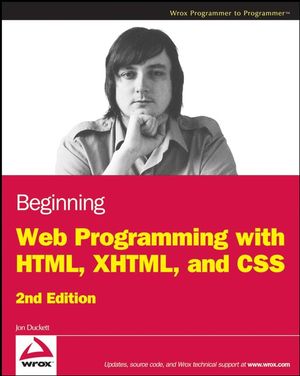Beginning Web Programming with HTML, XHTML, and CSS, 2nd EditionISBN: 978-0-470-25931-3
Paperback
768 pages
April 2008
 This title is out-of-print and not currently available for purchase from this site.
|
Introduction xxiii
Chapter 1: Creating Structured Documents 1
A Web of Structured Documents 1
Introducing XHTML 2
Core Elements and Attributes 9
Attribute Groups 12
Basic Text Formatting 16
Presentational Elements 26
Phrase Elements 29
Lists 36
Editing Text 45
Using Character Entities for Special Characters 47
Comments 47
The <font> Element (deprecated) 48
Understanding Block and Inline Elements 48
Grouping Elements with <div> and <span> 49
Summary 50
Exercises 51
Chapter 2: Links and Navigation 53
Basic Links 54
Understanding Directories and Directory Structures 57
Creating Links with the <a> Element 65
Advanced E-mail Links 74
Summary 75
Exercises 76
Chapter 3: Images and Objects 77
Adding Images to Your Site 77
Adding Other Objects with the <object> Element 93
Using Images as Links 99
Image Maps 100
Summary 105
Exercises 106
Chapter 4: Tables 109
Introducing Tables 109
Basic Table Elements and Attributes 112
Advanced Tables 125
Accessibility Issues with Tables 132
Summary 136
Exercises 136
Chapter 5: Forms 139
Introducing Forms 140
Creating a Form with the <form> Element 141
Form Controls 145
Creating Labels for Controls and the <label> Element 169
Structuring Your Forms with <fieldset> and <legend> Elements 171
Focus 173
Disabled and Read-Only Controls 176
Sending Form Data to the Server 178
Summary 183
Exercises 183
Chapter 6: Frames 185
Introducing the Frameset 185
When to Use Frames 188
The <frameset> Element 189
The <frame> Element 194
The <noframes> Element 197
Creating Links Between Frames 198
Nested Framesets 200
Floating or Inline Frames with <iframe> 204
Summary 209
Exercises 209
Chapter 7: Cascading Style Sheets 211
Introducing CSS 212
Where You Can Add CSS Rules 217
CSS Properties 221
Controlling Fonts 223
Text Formatting 230
Text Pseudo-Classes 239
Selectors 243
Lengths 249
Percentages 251
Introducing the Box Model 251
Summary 270
Exercises 270
Chapter 8: More Cascading Style Sheets 273
Links 274
Backgrounds 275
Lists 283
Tables 287
Outlines 294
The :focus and :active Pseudo-Classes 296
Generated Content 297
Miscellaneous Properties 301
Additional Rules 304
Positioning with CSS 305
Summary 320
Exercises 321
Chapter 9: Page Layout 323
Understanding the Site 323
Page Size (and Screen Resolution) 330
Designing Pages 337
Structuring Pages 346
Summary 359
Exercises 359
Chapter 10: Design Issues 361
Text 362
Navigation 369
Shading Multiple Rows of a Table 378
Forms 380
Summary 401
Exercises 401
Chapter 11: Learning JavaScript 403
What Is Programming About? 404
How to Add a Script to Your Pages 406
The Document Object Model 410
Starting to Program with JavaScript 422
Variables 423
Operators 424
Functions 427
Conditional Statements 429
Looping 432
Events 435
Built-in Objects 437
Writing JavaScript 449
Summary 451
Exercises 452
Chapter 12: Working with JavaScript 453
Practical Tips for Writing Scripts 453
Form Validation 456
Form Enhancements 470
Image Rollovers 482
Random Script Generator 485
Pop-Up Windows 486
JavaScript Libraries 487
When Not to Use JavaScript 496
Summary 498
Exercises 498
Chapter 13: Putting Your Site on the Web 501
Meta Tags 502
Testing Your Site 508
Taking the Leap to Live 517
What Next? 529
Introducing Other Technologies 531
Summary 537
Appendix A: Answers to Exercises 539
Appendix B: XHTML Element Reference 563
Appendix C: CSS Properties 607
Appendix D: Color Names and Values 637
Appendix E: Character Encodings 645
Appendix F: Special Characters 649
Appendix G: Language Codes 665
Appendix H: MIME Media Types 669
Appendix I: Deprecated and Browser-Specific Markup 681
Index 715



